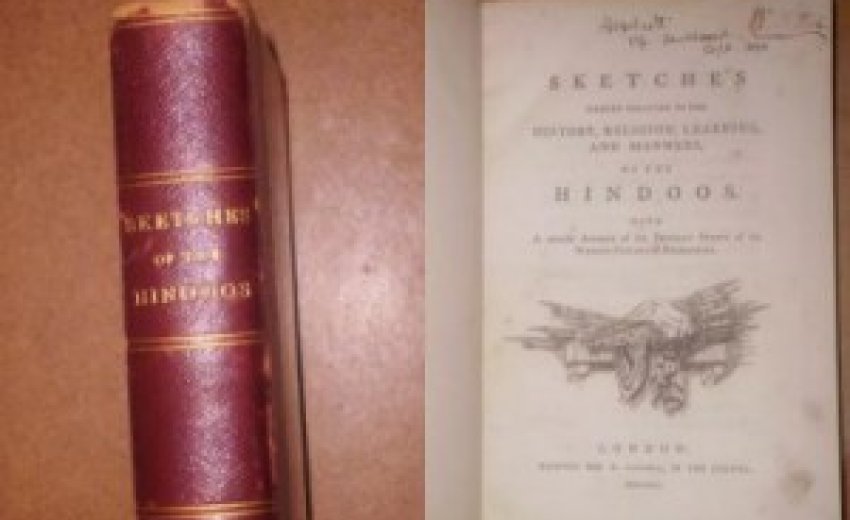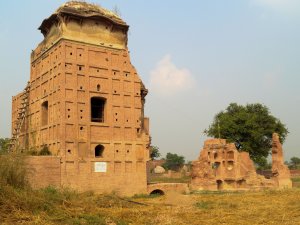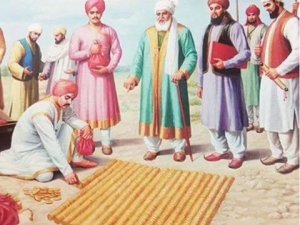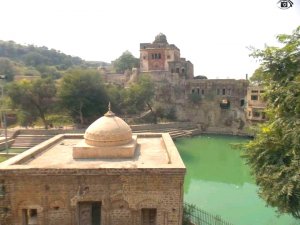A Scotsman’s account on Sikhs
Inderjeet Singh
This paper intends to share with students of Sikh history an account on Sikhs by Quintin Craufurd1 originally written in 1790. This account is taken from his book The History, Religion, Learning and Manners of the Hindus. Although the book has been in the public domain for over 200 years but it has hardly been mentioned by the Sikh historians2. The extract from the above book relating to Sikhs is produced for general reference and for readers to draw their own conclusion. This short extract can be an addition to the 18th century European accounts on Sikhs.
Quintin Craufurd was bom in 1743 in Scotland. He came to India in his early life and
entered into the service with East India Company. In 1790 he wrote the book The
History, Religion, Learning and Manners of the Hindus in two volumes. He does not
mention Sikhs in his first volume. However in Sketch 2 of the first volume (the author
uses the word sketch rather than chapter), Craufurd expresses his gratitude to Colonel
Polier, John Stuart and George Forster3. These names are quite familiar to the students
of Sikh history.
The first reference to the Sikhs is made on page 254 of volume 2 in Sketch 15 ‘History & Political State of the present native Powers of Hindostan’. Craufurd states that when Timur Shah, son of Ahmed Shah Abdali who was left as latter protege in his Indian conquest which included Punjab was frequently disturbed by the Sikhs. In the footnote the author defines Sikhs as ‘A tribe of Hindoos, who possess deism’. He further adds that the word Sikh is said to mean disciple. In volume 2 the Scot makes passing references to Sikhs on couple of pages in relation to Abdali’s invasion. His account on Sikhs starts on page 263 and runs in 14 pages.
The account has some obvious inaccuracies which are not out of ordinary when compared with other 18th century European accounts on Sikhs. The author fails to mention Khalsa and the circumstances which led to Sikhs to take up arms and defend their faith. However Craufurd account is not a biased like Col. Polier’s account4. The author had some knowledge about philosophy of religion(s) which is evident when he states that Sikhs possess deism5. Deists typically reject supernatural events such as prophecy and miracles, tending to assert that God (or The Supreme Architect’) has a plan for the universe that is not to be altered by intervention in the affairs of human life. Deists believe in the existence of one supreme God only.
He interprets that Guru Nanak become admirer of Narghenny worship which in all probability is the concept of Nirgun(a) found in Hindu philosophy of Vedanta. In Sikh religion the God is both Nirgun (without attributes) and Sargun (with attributes). Guru Granth Sahib on page 250 states ‘Nirankaar aakaar aap nirgun sargun ayk’. ‘Aap akaar aap nirankaar’ (p863 GGS) ‘Raaj joban prabh thoon dhanee, thoon nirguna thoon sarguna’
Craufurd states that Guru Nanak ‘stripped the religion of Brimha of its mythology’ and the Sikhs are monotheistic. He adds that Sikhs fondly remember their Gurus but ‘they neither offer them divine worship, nor apply to them to intercede in their behalf.’
A fascinating aspect on this account is Craufurd interpretation on the blue dress worn by Khalsa. He states that blue is generally considered as an inauspicious colour by the Hindus is the colour of the Sikhs as dictated by their Gurus. He adds that the Guru perhaps meant to show by this, ‘the weakness and absurdity of superstitious prejudices.’ Craufurd shares the difference in Sikh religion and their way of life in comparison to Hindus in general. He seems to be contradicting his early statement made in the first volume where he describes Sikhs as a tribe of Hindus.
Interestingly Craufurd mentions that Sikhs were not without suspicion that the assassination attempt on their last Guru which fatally wounded him was undertaken by the secret order of the Emperor Bahadur Shah. Traditional Sikh sources like Mehma Prakash & Rattan Singh Bhangoo’s Prachin Path Prakash blame Wazir Khan the Subedar of Sirhind for conspiring and sending spies to murder the tenth Guru. A contemporary Persian source Akhbar-i-Darbar-i-Mualla6 gives information regarding the Pathan who fatally wounded Guru Gobind Singh as Jamshed Khan. He treacherously attacked the Guru and was subsequently killed by the Guru. This Persian source states that the Emperor bestowed on the son of the killed Khan a robe of mourning. One can deduce that the attack on Guru Gobind Singh was made with the knowledge of Mughal Emperor and the latter knew the attacker. Outwardly Bahadur Shah was friendly towards the Guru but he had sinister motive to get rid of the Guru. Hari Ram Gupta is of the opinion that Bahadur Shah was involved in the conspiracy to kill the Guru7. Modem Sikh historians like Kirpal Singh & Harbans Singh Noor also second this view.8
It seems that till late 18th century at least some Sikhs believed that Bahadur Shah had some hand in the assassination attempt of Guru Gobind Singh. Some how this belief got lost in time till the translation of the above stated Persian source was brought to the attention of Sikh community in latter half of the 20th century.
The writer of the paper hopes that general readers and students of Sikh history will find the account useful and this will be seen as an addition to the other early European accounts on Sikhs.
Sketches chiefly relating to the History, Religion, Learning & Manners of the Hindoos by Quentin Craufurd (Second Edition June 12, 1791)
Sketch XV- History & Political State of the present native Powers of Hindostan
Page 263-277
On crossing the Attuck, we now enter the territories of the Seiks, a people who owe their religious origin to a Hindoo, named Nanuck, of the Khatry or Rajah cast. His father, Baba Calou, possessed a small district in the province of Lahore, named Telvandi, where Nanuck was born in the year of Christ 14709. Many stories are told of wonderful indications given by him, in his infancy, of uncommon wisdom and sagacity. He seems to have possessed strong natural powers, but which received no further cultivation than the usual education of the young men of his cast, consisting in little more than learning to read and write; in being taught arithmetic; and hearing the Shastras, or dissertations on the law and religion of their country.
According to the custom of the Hindoos, he was married in his early years to one of his own tribe, by whom he had two sons.
It appears that he soon became an admirer of the Narghenny* worship, and used to declaim against the folly of idols, and the impiety of offering adoration to any but the Supreme Being.
(*see Vol 1 page 155, Craufurd defines Nargheeny as worship of the invisible, have no other object of adoration but that Being)
Having often expressed a desire to travel, at the age of about twenty-five years he quitted his family, and visited Bengal and most of the eastern provinces of Hindostan. In a second excursion he went to the south, it is said, as far as the island of Ceyloan and in a third, he went into Persia and Arabia. These different joumies seem to have taken up about fifteen years. But on his return from third, he declared his intention of not quitting his native country any more; and having expressed a wish of fixing his retreat on the border of some river, at a distance from any town, the Rajah of Calanore, who had become one of his disciples, granted him a piece of the land on the banks of Ravy, about 80 miles north-eastward from the city of Lahore. Here Nanuck established his abode for the rest of his days, in a convenient dwelling that was erected by the Rajah’s care and as he chose to be free from the affaires of this world, his wife and children dwelt at Calanore, coming occasionally to visit him. Having acquired great reputation for knowledge, wisdom, and piety, persons of all persuasions went to see him, and the Seiks say, that in his presence they forgot that there was any religion but one. He died about the age of seventy. The place of his abode was called Kartarpour, but since his death it has been named Dihra Daira, or the place of worship.
His eldest son, Serik-chund was the founder of a set of devotees, named Nanuck Shoiy. The second, called Letchimidan, married, and had several children. On account of the oppressions of the Mahomedan governors, he altogether forsook Telvandy, the estate of his ancestors, and settled at Kartarpour, which is still in possession of his descendants. But though are respected by the Seiks, as being the posterity of Nanuck, yet they are not held in any sacred veneration, nor considered as the heads of their religion or tribe.
Nanuck, when on his death-bed, passing by his children and relations, named as his successor, to teach his doctrine, a favourite disciple, named Lhina, but whom he then called Angud, which is said to signify, similar. Angud was likewise of the Khatry cast, and of a respectable family in the same province where Nanuck was bom. To him he entmsted the care of collecting his precepts, which he according did, in a work called Pothy, or the book and in another work called Jenum Sakhy, he gave a history of Nanuck’s life. These are written in the Panjab dialect, but in a particular character called Gour Mouekty, said to have been invented by Nanuck himself for the purpose of writing his doctrine*.
(Footnote * Colonel Polier)
Angud, following the example of Nanuck, named to succeed him as Gourou, or holy master, his disciple Amerdoss; and this mode seems to have been practised, as long as the custom of obeying one supreme chief was observed.
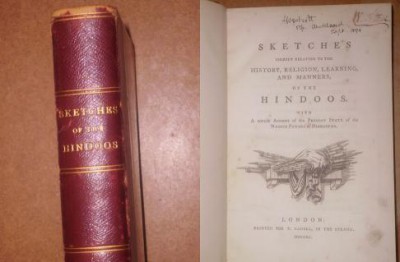 |
| "India – Sikh History Account of India and the Sikhs 1790 Quintin Craufurd. Sketches chiefly relating to the History Religion Learning and Manners of the Hindoos 1790. Quintin Craufurd (22 September 1743 – 23 November 1819) a British author In early life he went to India where he entered the service of the British East India Company." source |
Having, as already related, drawn on themselves the vengeance of Ahmed Shaw, he attacked them with his usual vigour. They were now under several chiefs, some of them descendants of their Gourous, and others of Hindoo nobles, who had adopted their faith, and united themselves with the nation. The war with the Affghans lasted several years, during which the Seiks retired into strong holds, or acted offensively in the field, according as they found themselves in force. But in the end they entirely expelled these northern invaders; and not only conquered all the extensive province of Lahore, but are now in possession of the greatest part of Moultan, and several districts towards Delhi, including in their territories the whole of that rich country called the Panjab.
Nanuck having stripped the religion of Brimha of its mythology, the Seiks adore God alone, without image or intermediation; and though they venerate the memory of their founder, as well as some of their Gourous, whose names they often repeat, yet they neither offer them divine worship, nor apply to them to intercede in their behalf.
They eat any sort of meat, excepting beef; retaining the same regard of the ox as the other Hindoos, and probably from same cause, its utility. But the meat which is very generally eaten, is pork; perhaps because forbidden to the Mahomedans.
Blue, which is generally considered as an inauspicious colour by the Hindoos, distinguishes the dress of the Seiks; as if Nanuck meant to show by this, the weakness and absurdity of superstitious prejudices. Their dress commonly consist in blue trowsers of cotton cloth; a sort of plaid, generally chequered with blue, which is thrown over the right shoulder, and a blue turban.
The national government is composed of an assembly of their different chiefs, but who individually are independent of each other, and masters of their respective territories. In this assembly every thing that regards the safety of the state, the quota of troops to be furnished by each chief in time of war, the operations of their armies, and the choice of the person to command them, is agitated; and resolved on by the plurality of voices. This assembly meets annually, or as occasion may require, at Anbertser14, a place held in a kind of religious veneration, where there is a large tank, which is said to be beautifully ornamented, lined with granit15, and surrounded with buildings.
The whole force of the different chiefs collectively may amount to about two hundred thousand horses. But they freedom can be brought to act in concert, unless the nation be threatened with general danger, in which case they never fail to unite.
Besides a sabre, most of their soldiers carry a matchlock gun, which seems a very uncouth weapon for a horseman; but in the use of it they are extremely expert, and are in general excellent marksmen. It carries a larger ball than an English musket to a greater distance; and is often employed by them with success, before the enemy be near enough to use the sword.
They are naturally a strong race of men, and, by their hardy manner of living, are capable of enduring much fatigue. In the field, none but the principal officers have tents, and these are extremely small, so that they may be struck and transported with quickness and facility. In cold weathers the soldier wraps himself, in the night, in a coarse blanket, which he marches, is folded and carried on his horse.
Of late years almost all the neighbouring countries have been laid under contributions by them; and, to avoid their incursions, several petty chiefs have consented to pay them a small tribute, and put themselves under their protection.
Their country is well cultivated; full of inhabitants, and abounds with cattle. The horses of Lahore are supposed to be much superior to those bred in any part of Hindostan.
It is said that they have a sort if superstitious respect for their sword. By their sword they obtained independence and power; and by it they preserve them. A Seik, though in other respects infinitely less scrupulous than any other Hindoo, before he will eat with any one of another religion, draws his sword, and passing it over the victuals, repeat some words of prayer, after which he will freely partake of them*.
Contrary to the practice of all the other inhabitants of Hindostan, they have an aversion to smoking tobacco. But many of the people smoke and chew bang, so as sometimes to produce a considerable degree of intoxication+.
(Footnote * Mr. Stuart + Colonel Polier)
After leaving the Seiks, we come to the provinces of Delhi.........
Notes & references
1. QUINTIN CRAUFURD*(1743-1819) was bom at Kilwinnock, Scotland on the 22nd of September 1743. In early life he went to India, where he entered the service of the East India Company. In 1790 he wrote The History, Religion, Learning and Manners of the Hindus in two volumes. . He returned to Europe before the age of forty with a ‘handsome’ fortune and settled in Paris. Here he is said to give himself to the cultivation of literature and art, and formed a good library and collection of paintings, coins and other objects of antiquarian interest. Craufurd was said to be close to the French Court and on intimate terms with Marie Antoinette (Queen of France). He escaped to Brussels during the French Revolution but managed to returned and live in Paris till his death on 23rd November 1819.
He wrote, among other works, Secret History of the King of France and his Escape from Paris (first published in 1885), Researches concerning the Laws, Theology, Learning and Commerce of Ancient and Modern India (1817), History of the Bastille (1798), On Pericles and the Arts in Greece (1815), Essay on Swift and his Influence on the British Government (1808), Notice sur Marie Antoinette, (1809), Memoires de Mme du Hausset (1808). * Volume V 07, Page 382 of the 1911 Encyclopedia Britannica2. Punjab Past & Present, the special commemorative issue on 500th birth centurial of Guru Nanak contains a partial extract of the Craufurd account on Sikhs. The extract produced in the above book/journal finishes where the author ends his account on Guru Nanak
3. On page 76/77 the author writes I am indebted for much curious, as well as useful, information to Lieutenant Colonel Polier, Mr. John Stuart and Mr. George Forster. Lieutenant Colonel Polier resided nearly thirty years in Hindostan, part of which he spent at Delhy, and its neighbourhood. Mr. Stuart and Mr. Forster have visited more of the interior parts of India than any other Englishman I have heard of)
See Colonel Polier & George Forster account in Sicques, Tigers, or Thieves: Eyewitness Accounts of the Sikhs (1606-1809) by Amandeep Singh Madra, Parmjit Singh4. Dr Ganda Singh: Early European Accounts on Sikhs
5. Deism in the philosophy of religion is the standpoint that reason and observation of the natural world, without the need for organized religion, can determine that a supreme being created the universe. Further the term often implies that this Supreme Being does not intervene in human affairs or suspend the natural laws of the universe. Deists typically reject supernatural events such as prophecy and miracles, tending to assert that God (or "The Supreme Architect") has a plan for the universe that is not to be altered by intervention in the affairs of human life. Deists believe in the existence of God without any reliance on revealed religion, religious authority or holy books. This idea is also known as the Clockwork universe theory, in which God designs and builds the universe, but steps aside to let it run on its own. Two main forms of deism currently exist: classical deism and modem deism
6. Akhbarat-i-Darbar-i-Mualla, News of the royal Mughal Court, Punjab Past and Present, Vol VIII, Part 2, October 1984, Punjabi University, Patiala.
7. Hari Ram Gupta: History of Sikhs Volume 1 Manohar Publishers, Delhi 1984
8. Kirpal Singh: Significance of Contemporary Persian Sources Relating to Guru Gobind Singh, Institute of Sikh Studies, Chandigarh
Harbans S Noon Guru Gobind Singh - The Last Journey in ‘Connecting Dots in the Sikh History* (Institute of Sikh Studies, Chandigarh 2004)9. Guru Nanak was bom in 1469
10. Guru Tegh Bahadur. His father Guru Hargobind Sahib, the 6th Guru who started the doctrine of Miri & Piri was the first Guru to arm the Sikhs.
11. Pathan
12. Banda Singh Bahadur
13. Nadir Shah. The author probably confused Nadir Shah with Ahmed Shah Abdali. The so called atrocities perpetuated by the Sikhs under Banda Singh Bahadur are highly exaggerated in the Persian chronicles. The author seems to borrow from them and unknowing put them in post Banda Bahadur period which was characterised by state sponsored annihilation of the Sikhs.
14. Amritsar
15. Guru Granth Sahib

